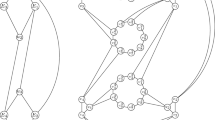Abstract
We consider the \(k\) -disjoint-clique problem. The input is an undirected graph \(G\) in which the nodes represent data items, and edges indicate a similarity between the corresponding items. The problem is to find within the graph \(k\) disjoint cliques that cover the maximum number of nodes of \(G\). This problem may be understood as a general way to pose the classical ‘clustering’ problem. In clustering, one is given data items and a distance function, and one wishes to partition the data into disjoint clusters of data items, such that the items in each cluster are close to each other. Our formulation additionally allows ‘noise’ nodes to be present in the input data that are not part of any of the cliques. The \(k\)-disjoint-clique problem is NP-hard, but we show that a convex relaxation can solve it in polynomial time for input instances constructed in a certain way. The input instances for which our algorithm finds the optimal solution consist of \(k\) disjoint large cliques (called ‘planted cliques’) that are then obscured by noise edges inserted either at random or by an adversary, as well as additional nodes not belonging to any of the \(k\) planted cliques.

Similar content being viewed by others
References
Alon, N., Krivelevich, M., Sudakov, B.: Finding a large hidden clique in a random graph. Rand. Struct. Alg. 13, 457–466 (1998)
Ames, B., Vavasis, S.: Nuclear norm minimization for the planted clique and biclique problems. Math. Program. 129(1), 1–21 (2011)
Berkhin, P.: A survey of clustering data mining techniques. In: Kogan, J., Nicholas, C., Teboulle, M. (eds.) Grouping Multidimensional Data, pp. 25–71, chapter 2. Springer, Heidelberg (2006)
Boyd, S., Vandenberghe, L.: Convex Optimization. Cambridge University Press, Cambridge (2004)
Candès, E.J., Li, X., Ma, Y., Wright, J.: Robust principal component analysis? J. ACM 58(3), 11 (2011)
Candès, E.J., Recht, B.: Exact matrix completion via convex optimization. Found. Comput. Math. 9(6), 717–772 (2009)
Chandrasekaran, V., Sanghavi, S., Parrilo, P.A., Willsky, A.S.: Rank-sparsity incoherence for matrix decomposition. SIAM J. Optimiz. 21(2), 572–596 (2011)
Feige, U., Krauthgamer, R.: Finding and certifying a large hidden clique in a semirandom raph. Rand. Struct. Alg. 16(2), 195–208 (2000)
Füredi, Z., Komlós, J.: The eigenvalues of random symmetric matrices. Combinatorica 1(3), 233–241 (1981)
Garey, M.R., Johnson, D.S.: Computers and Intractability: A Guide to the Theory of NP-Completeness. W. H. Freeman and Co, New York (1979)
Geman, S.: A limit theorem for the norm of random matrices. Ann. Probab. 8(2), 252–261 (1980)
Golub, G., Van Loan, C.: Matrix Computations, 3rd edn. Johns Hopkins University Press, Baltimore (1996)
Hoeffding, W.: Probability inequalities for sums of bounded random variables. J. Am. Stat. Assoc. 58, 13–30 (1962)
Jalali, A., Chen, Y., Sanghavi, S., Xu, H.: Clustering partially observed graphs via convex optimization. Arxiv preprint arXiv:1104.4803 (2011)
Mitzenmacher, M., Upfal, E.: Probability and computing. Cambridge University Press, Cambridge, Randomized algorithms and probabilistic analysis (2005)
Ostrovsky, R., Rabani, Y., Schulman, L., Swamy, C.: The effectiveness of Lloyd-type methods for the k-means problem. In: Proceedings of the 47st Annual IEEE Symposium on the Foundations of Computer Science (2006)
Oymak, S., Hassibi, B.: Finding dense clusters via “low rank + sparse” decomposition. Arxiv, preprint arXiv:1104.5186 (2011)
Recht, B., Fazel, M., Parrilo, P.A.: Guaranteed minimum-rank solutions of linear matrix equations via nuclear norm minimization. SIAM Rev. 52(3), 471–501 (2010)
Zhao, X.Y., Sun, D., Toh, K.C.: A newton-cg augmented lagrangian method for semidefinite programming. SIAM J. Optimiz. 20(4), 1737–1765 (2010)
Author information
Authors and Affiliations
Corresponding author
Additional information
Supported in part by a Discovery Grant and Postgraduate Scholarship (Doctoral) from NSERC (Natural Science and Engineering Research Council of Canada), MITACS (Mathematics of Information Technology and Complex Systems), and the US Air Force Office of Scientific Research.
Rights and permissions
About this article
Cite this article
Ames, B.P.W., Vavasis, S.A. Convex optimization for the planted k-disjoint-clique problem. Math. Program. 143, 299–337 (2014). https://doi.org/10.1007/s10107-013-0733-1
Received:
Accepted:
Published:
Issue Date:
DOI: https://doi.org/10.1007/s10107-013-0733-1




